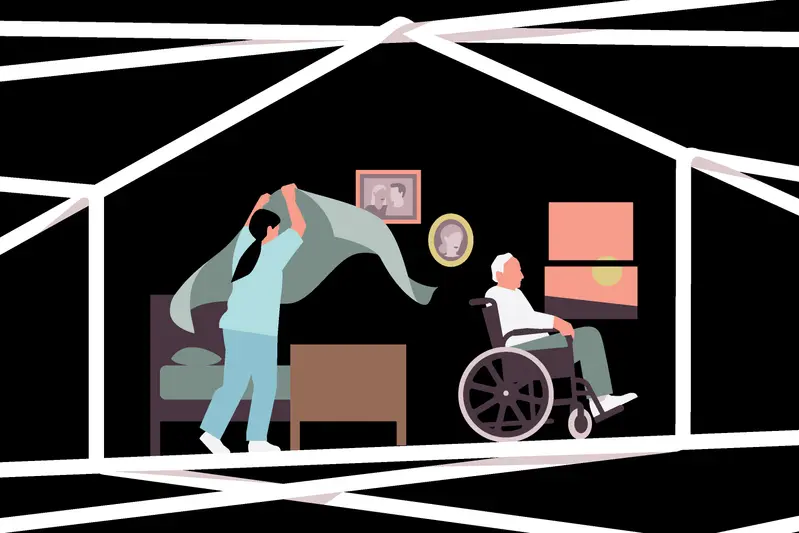Hospices in Four States to Receive Extra Scrutiny Over Concerns of Fraud, Waste and Abuse
Our “Nursing Home Inspect” tool is now easier to use. Here’s what you can find when searching our database by state, county or facility.


Series: The Hospice Hustle
How a Visionary Movement Became a Plaything for Profiteers
Last week, regulators rolled out enhanced oversight for new hospices in Arizona, California, Nevada and Texas. The Centers for Medicare and Medicaid Services, which pays for most of American hospice care, announced that this change was spurred by “numerous reports of hospice fraud, waste, and abuse” and “serious concerns about market oversaturation.”
In November, ProPublica and The New Yorker highlighted that the four states were overrun with for-profit hospices, many of them sharing the same addresses and owners. Some of these hospices obtained licenses only to sell them to other entrepreneurs. Others appeared to be billing Medicare for “phantom” — that is, nonexistent — patients. Some did both. The government’s own data revealed a pattern of rapid hospice growth in the four states, far outstripping the demand for services.
Rapid Rise in Hospices Concentrated in West and Southwest
A ProPublica analysis of Medicare data reveals a sharp uptick in providers since 2018.

2,000 Medicare-certified hospices
California
1,500
1,000
Texas
500
Georgia
Arizona
Nevada
New York
1983
1990
2000
2010
2022

2,000 Medicare-certified hospices
California
1,500
1,000
Texas
500
Georgia
Arizona
Nevada
New York
1983
1990
2000
2010
2022
During the new oversight period, which can last up to a year, Medicare and its contractors will now scrutinize the claims submitted by new hospices in these states before they pay them. This process — often known as “medical review” or “pre-pay review” — will make it more difficult for a hospice to bill the government for inappropriate patients or medically unnecessary services. Theresa Forster, vice president for end-of-life care policy at the National Association for Home Care & Hospice, praised this action, which all four industry trade groups had recommended. “This gives new hospices an opportunity to start off on the right foot and identify any problem areas from the start,” she said.
The change is part of a larger effort by CMS this year to address fraud, waste and abuse in its hospice program. In January, CMS overhauled its inspections of hospices, with the changes going into effect immediately. In March, the agency released a proposed rule that would require further analysis of the number of patients leaving hospice alive, the diagnoses provided on hospice claims and Medicare hospice spending. And in April, the agency made hospice ownership data public for the first time. The data will allow patients and families to better discern whether their hospice is for-profit or not-for-profit — a distinction that, as researchers have shown, can significantly affect the quality of care. “It’s plain and simple: families deserve transparency when making decisions about hospice and home health care for their loved ones,” Department of Health and Human Services Secretary Xavier Becerra said in a statement. “Shining a light on ownership data is good for families, good for researchers, and good for enforcement agencies.”
These reforms were prompted not just by the ProPublica-New Yorker story but by the continued pressure from lobbyists and lawmakers in its wake. This spring, during hearings held by the Senate Finance and House Ways and Means committees, members cited the investigation as they questioned Becerra on the agency’s next steps for tackling hospice profiteering. In one exchange, Becerra testified that his inspectors had “conducted some unannounced site visits of the hospices identified by that article” and that an audit of suspicious providers was underway. Legislators have sent a series of public letters to HHS, requesting urgent briefings and actions on hospice fraud, including two this summer. The most recent letter, released last week and signed by 26 representatives from both parties, applauded CMS’ commitment to addressing hospice abuse while also requesting further reforms, including targeted moratoriums in high-growth areas and standards to rein in deceptive marketing practices.
“This is an area that escapes partisan gridlock,” Rep. Earl Blumenauer, D-Ore., one of the letter’s signatories and coordinators, told me. “No one sympathizes with people who are cheating this system, particularly when you are involving some of America’s most vulnerable populations.”
Palliative care physicians have also been pushing for stricter guidelines. In April, the Journal of Palliative Medicine published a statement of “Core Roles and Responsibilities” signed by 325 doctors in the field. The group was motivated to issue the statement, it wrote, “out of concern for physician colleagues who may be asked to participate in hospice programs that are staffed, structured, and operated in ways that put patients and families at risk of poor care, and concomitantly expose physicians to violations of clinical and ethical standards.” Among other improvements, it called for hospices to strengthen their staffing, training and frequency of visits.
Ira Byock, the lead author and the former president of the American Academy of Hospice and Palliative Medicine, said that the condition of hospice care in the United States represented a “true public health crisis.”
This year has also seen a spate of further reporting, commentary and research on the profit motive in hospice, including a detailed report on private equity’s role in hospice care from the Center for Economic and Policy Research. Eileen Appelbaum, the center’s co-director and one of the co-authors of the report, “Preying on the Dying,” said that she has long been concerned about how investors can harm vulnerable patients and families. “Problems of asymmetric information — most patients and their caregivers have no prior experience with hospice care — further increase the difficulty of overseeing private hospice agencies,” the report notes.
Ben Marcantonio, the interim CEO at the National Hospice and Palliative Care Organization, the industry’s largest trade group, said that “in my experience, whether hospices are gaming the system is not a direct reflection of tax status. What we need is the right stewardship of taxpayer dollars, so the right delivery of care is provided at the right time with the right amount of resources.”
Blumenauer told me that he and other legislators were committed to checking in with CMS and trade groups like NAHC and NHPCO about ongoing, collaborative efforts to reform the hospice program. “Your article struck a chord on a series of levels,” he said. “We are going to continue pounding away on this issue.”
ProPublica is a nonprofit newsroom that investigates abuses of power. Sign up to receive our biggest stories as soon as they’re published.
ProPublica is a nonprofit newsroom that investigates abuses of power. Sign up to receive our biggest stories as soon as they’re published.






